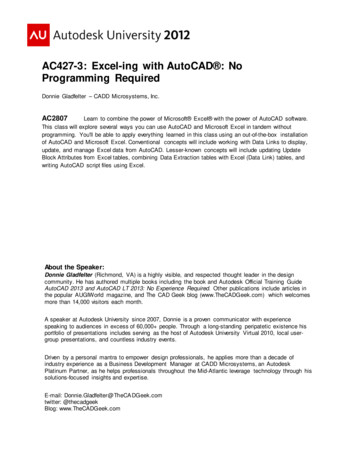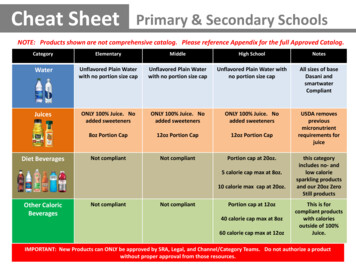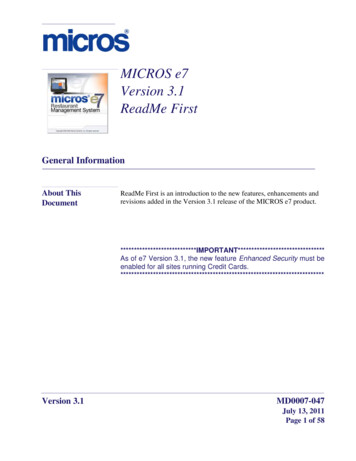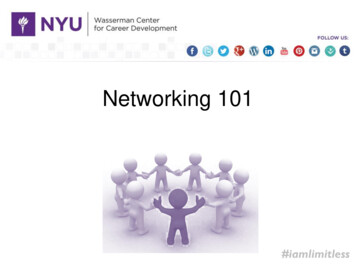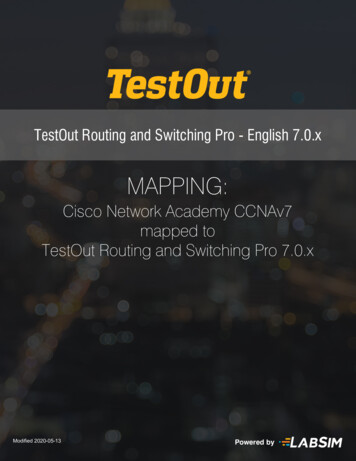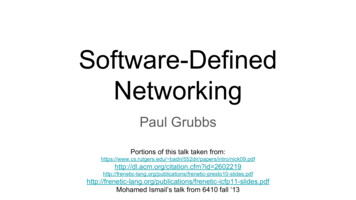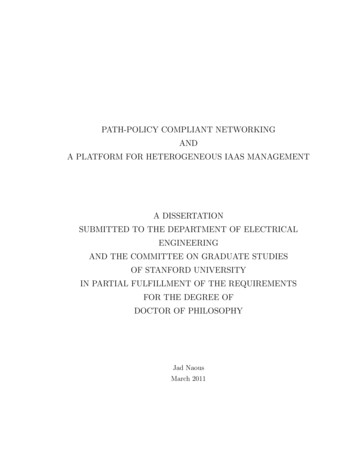
Transcription
PATH-POLICY COMPLIANT NETWORKINGANDA PLATFORM FOR HETEROGENEOUS IAAS MANAGEMENTA DISSERTATIONSUBMITTED TO THE DEPARTMENT OF ELECTRICALENGINEERINGAND THE COMMITTEE ON GRADUATE STUDIESOF STANFORD UNIVERSITYIN PARTIAL FULFILLMENT OF THE REQUIREMENTSFOR THE DEGREE OFDOCTOR OF PHILOSOPHYJad NaousMarch 2011
AbstractThis thesis is in two parts.Path-Policy Compliant NetworkingThe Internet gives little control to the end-points of a communication over the actualinterdomain path taken by that communication through the network. Such a controlcan be quite useful. Unfortunately, unchecked, this capability can threaten providers’viability. Providers want to ensure that they are compensated for their servicesand that paths that end-points choose comply with the providers’ policies. Even ifproviders did want to give such control to senders and receivers, the Internet doesnot give providers such ability. Not only does the Internet not have a mechanism toenable senders and receivers to specify a choice of path that complies with providers’transit policies, it does not have a mechanism to enforce that choice and thus thepolicies of senders, receivers, and transit providers.The icing project aims to fill that void in three stages. The first stage is apacket forwarding mechanism, icing-pvm, that provides the missing capabilitiesabove. icing-pvm allows a sender to specify the path to use for its traffic, but itrequires the sender to obtain authorization from all entities on that path before usingit. Upon receiving a packet, each entity on the path can verify that it had previously approved the packet’s path, and that the packet is following that path. Thusicing-pvm separates policy from mechanism, and authorization from authentication.The second stage is an overlay network, icing-on, that enables senders and receivers to specify overlay waypoints and in-network services for traffic between them.icing-on uses DNS as a bootstrapping mechanism for finding paths and obtainingiv
authorization.But an overlay network side-steps many of the complexities of a network architecture that can replace the Internet, such as how to obtain authorization to obtainauthorization. So, the third stage is a network architecture, icing-L3, that enablesa sender to discover and choose paths towards a destination, without using IP as acrutch.A Platform for Heterogeneous IaaS ManagementMany new innovations in networking cannot be deployed today because they requirea significant change to the Internet infrastructure or because their scale is too large.To overcome this hurdle, the National Science Foundation (NSF) started GENI, theGlobal Environment for Network Innovations.GENI is a federation of existing and new Infrastructure-as-a-Service providersthat contribute computing and networking resources to be used for deploying newapplications and experiments. Some of these IaaS providers are PlanetLab, Emulab,and campuses running OpenFlow networks. GENI will enable a researcher to obtaina coherent slice of infrastructure across resource types and providers.Building the management framework that enables researchers to do so is an ongoing concern. The community is converging towards a unified API across all typesof resources and providers. But it is not clear if such a solution will be the correctone for the future. A rigid unified API may not allow the community to experimentwith different design choices and deployment models.This thesis discusses an alternative design, Expedient. Expedient is a management platform for GENI that follows two principles: reuse and pluggability. Expedientleverages existing Web technologies to quickly prototype and experiment with newfeatures and user interfaces. It is built as a pluggable website that uses heterogeneous APIs to communicate with each IaaS provider, and uses as a starting designpoint a centralized deployment model that enables federated management. Expedient has enabled us to quickly build infrastructure to slice OpenFlow networks and todemonstrate coherent continuous slices across PlanetLab IaaS providers and OpenFlow network IaaS providers.v
AcknowledgementsMy parents, just like any Middle Eastern parents, wanted me to become a doctor,and I always said that it would take too much time. Little did they and I know thatnot only will I become a doctor, but the wrong kind of doctor. First and foremost,I want to thank my parents for their unrelenting support and love. My parents havesacrificed more than I think I will ever be able to, so that my brothers and I can behappy and successful. I only hope one day I will be able to repay them this incredibledebt and be strong enough to do the same for my children.When I came to Stanford, I was set on graduating with only a Master’s in Computer Science. But there were so many interesting things happening in Stanford, somany interesting people to talk to, and my advisor Prof. Nick McKeown. If it hadnot been for Nick, I would not have had many of the experiences that have shapedmy current career path. Nick has taught me much about being an “adult”, and mostimportantly, how to have long-term focus and have an impact. So, thank you, Nick,for being such a powerful role model, for helping me define the term “success”, andfor giving me the opportunities that have led me to where I am today.I wish to thank Prof. David Mazières for his incredible dedication to his students.And I really do mean incredible. I have never heard any of David’s students evercomplain about him. Very few people with David’s other-worldly intelligence are aswilling to listen to students and give them the benefit of the doubt. Thank you,David, for helping me form the greater part of my thesis at a dark time during mystudent career.I met Prof. Michael Walfish when he was a postdoc at Stanford. Mike has taughtme much about being careful, about writing, and about being a graduate student.vi
Thank you, Mike, for being a great mentor.My work on icing and Expedient was only possible because of my collaborators.For icing, thanks go to Michael Walfish, David Mazières, Antonio Nicolosi, ScottShenker, Arun Seehra, and Mike Miller. For Expedient, thanks go to Guido Appenzeller, Peyman Kazemian, Nick McKeown, Guru Parulkar, Srini Seetharaman, andRob Sherwood.Finally, I want to thank my friends and colleagues at Stanford who have mademy journey enlightening both at an intellectual and spiritual level. Thank you,Archan Padmanabhan, Corina Dumitrescu, Zuley Rivera Alvidrez, Guido Appenzeller, Neda Beheshti, Andrea Bittau, Prof. Dan Boneh, Martı̀n Casado, Adam Covington, Jonathan Ellithorpe, David Erickson, Yashar Ganjali, Glen Gibb, DanielGiffin, Nikhil Handigol, Brandon Heller, Abdul Kader Kabbani, Peyman Kazemian,Sean Kendall, Masa Kobayashi, Prof. John Lockwood, Diego Ongaro, Stephen Rumble, Srini Seetharaman, Raunaq Shah, Rob Sherwood, Ryan Stusman, Paul Tarjan,David Terei, David Underhill, Greg Watson, Paul Weissmann, Tatsuya Yabe, KokKiong “KK” Yap, Yiannis Yiakoumis, Prof. Nickolai Zeldovich, and James HongyiZeng.vii
PrefaceMy research work at Stanford can be divided into two main projects: icing andExpedient. The organization of this dissertation reflects this division. But eventhough both projects are quite independent of each other, they both share a commontheme: they both attempt to provide a field over which the concerns and policies ofvarious stakeholders can play out.The icing project aims to build a network architecture that empowers the endpoints of a communication by giving them control over the path used for the communication. The challenge is providing this control without violating the policies of theproviders carrying the communication’s traffic and ensuring that the path is followed.icing consists of a number of sub-projects: icing-pvm, icing-on, and icing-L3.Expedient is an answer to the following question: How can users manage resourcesacross a federated set of Infrastructure-as-a-Service (IaaS) providers? These resourcesmay be heterogeneous, consisting of different types of network, compute, or otherresources, they may be sliced, virtualized, or fully delegated, and they may cross trustboundaries. Expedient provides a platform that gives users access to all resourcesusing one set of credentials, does not require infrastructure developers to change theirsystems, and allows infrastructure providers to enforce their policies concerning theuse of their resources. This dissertation discusses Expedient in the context of GENI,a federated set of IaaS providers with the goal of providing resources for experimentalnetwork research.The dissertation is divided into two parts, each of which can stand independentlyof the other: icing and Expedient. Aspects of icing have previously appearedin [146] and [123].viii
To my parents, Toufik and Nahida Naous.ix
ING11 Introduction22 Enforcing path policies with ICING-PVM42.1Introduction . . . . . . . . . . . . . . . . . . . . . . . . . . . . . . . .42.2Overview of icing-pvm . . . . . . . . . . . . . . . . . . . . . . . . .72.2.1Architecture and components . . . . . . . . . . . . . . . . . .82.2.2Goals and non-goals . . . . . . . . . . . . . . . . . . . . . . .92.2.3Threat model . . . . . . . . . . . . . . . . . . . . . . . . . . .102.2.4Naming . . . . . . . . . . . . . . . . . . . . . . . . . . . . . .112.2.5Proofs of consent (PoCs) . . . . . . . . . . . . . . . . . . . . .122.2.6Packet creation and proofs of provenance (PoPs) . . . . . . . .122.2.7Packet processing: verification and forwarding . . . . . . . . .13Design details of ICING-PVM . . . . . . . . . . . . . . . . . . . . .142.3.1Generating PoCs and controlled delegation . . . . . . . . . . .162.3.2Creating a packet . . . . . . . . . . . . . . . . . . . . . . . . .182.3.3Forwarding and receiving a packet . . . . . . . . . . . . . . . .202.3x
2.3.4Signaling errors and failures . . . . . . . . . . . . . . . . . . .202.3.5Attacks . . . . . . . . . . . . . . . . . . . . . . . . . . . . . .212.4Implementation . . . . . . . . . . . . . . . . . . . . . . . . . . . . . .232.5Evaluation . . . . . . . . . . . . . . . . . . . . . . . . . . . . . . . . .242.5.1Packet overhead . . . . . . . . . . . . . . . . . . . . . . . . . .252.5.2ICING-PVM hardware . . . . . . . . . . . . . . . . . . . . .262.5.3ICING-PVM software . . . . . . . . . . . . . . . . . . . . . .282.5.4Scaling . . . . . . . . . . . . . . . . . . . . . . . . . . . . . . .282.5.5Overhead of PoC generation . . . . . . . . . . . . . . . . . . .312.6Applications of ICING-PVM . . . . . . . . . . . . . . . . . . . . . .312.7Discussion . . . . . . . . . . . . . . . . . . . . . . . . . . . . . . . . .323 ICING-ON: A Policy-Compliant Overlay Network343.1Introduction . . . . . . . . . . . . . . . . . . . . . . . . . . . . . . . .343.2Design . . . . . . . . . . . . . . . . . . . . . . . . . . . . . . . . . . .363.2.1Overlay nodes and consent servers . . . . . . . . . . . . . . . .363.2.2ICING-ON gateways . . . . . . . . . . . . . . . . . . . . . .373.2.3DNS entries . . . . . . . . . . . . . . . . . . . . . . . . . . . .383.2.4To overlay or not to overlay . . . . . . . . . . . . . . . . . . .383.3Example . . . . . . . . . . . . . . . . . . . . . . . . . . . . . . . . . .403.4Discussion . . . . . . . . . . . . . . . . . . . . . . . . . . . . . . . . .424 ICING-L3: A Policy-Compliant Layer-3 Network464.1Introduction . . . . . . . . . . . . . . . . . . . . . . . . . . . . . . . .464.2Applications . . . . . . . . . . . . . . . . . . . . . . . . . . . . . . . .484.3Overview . . . . . . . . . . . . . . . . . . . . . . . . . . . . . . . . . .494.3.1ICING-L3 data plane . . . . . . . . . . . . . . . . . . . . . .504.3.2ICING-L3 control plane . . . . . . . . . . . . . . . . . . . . .51ICING-L3 control plane details . . . . . . . . . . . . . . . . . . . . .524.4.1Learning up-paths . . . . . . . . . . . . . . . . . . . . . . . .544.4.2Learning down-paths and sending packets . . . . . . . . . . .584.4.3Early drops . . . . . . . . . . . . . . . . . . . . . . . . . . . .594.4xi
4.54.4.4Delegation . . . . . . . . . . . . . . . . . . . . . . . . . . . . .604.4.5Optimizations . . . . . . . . . . . . . . . . . . . . . . . . . . .614.4.6Intradomain Routing . . . . . . . . . . . . . . . . . . . . . . .61Discussion . . . . . . . . . . . . . . . . . . . . . . . . . . . . . . . . .635 Related Work655.1Securing the network . . . . . . . . . . . . . . . . . . . . . . . . . . .655.2Related mechanisms . . . . . . . . . . . . . . . . . . . . . . . . . . .675.3Policy routing . . . . . . . . . . . . . . . . . . . . . . . . . . . . . . .676 ConclusionII696.1Summary . . . . . . . . . . . . . . . . . . . . . . . . . . . . . . . . .696.2Future Work . . . . . . . . . . . . . . . . . . . . . . . . . . . . . . . .706.3Insights . . . . . . . . . . . . . . . . . . . . . . . . . . . . . . . . . .71Expedient747 Expedient757.1Introduction . . . . . . . . . . . . . . . . . . . . . . . . . . . . . . . .757.2Overview . . . . . . . . . . . . . . . . . . . . . . . . . . . . . . . . . .847.3Design details . . . . . . . . . . . . . . . . . . . . . . . . . . . . . . .857.3.1Base platform . . . . . . . . . . . . . . . . . . . . . . . . . . .857.3.2ORM database . . . . . . . . . . . . . . . . . . . . . . . . . .877.3.3Connectors . . . . . . . . . . . . . . . . . . . . . . . . . . . .887.3.4Clients . . . . . . . . . . . . . . . . . . . . . . . . . . . . . . .88Creating end-to-end slices . . . . . . . . . . . . . . . . . . . . . . . .897.4.1Slicing an OpenFlow network . . . . . . . . . . . . . . . . . .907.4.2Connecting PlanetLab nodes . . . . . . . . . . . . . . . . . . .927.5Related Work . . . . . . . . . . . . . . . . . . . . . . . . . . . . . . .927.6Discussion . . . . . . . . . . . . . . . . . . . . . . . . . . . . . . . . .947.6.1Summary . . . . . . . . . . . . . . . . . . . . . . . . . . . . .947.6.2Future work . . . . . . . . . . . . . . . . . . . . . . . . . . . .957.4xii
7.6.3Lessons learned . . . . . . . . . . . . . . . . . . . . . . . . . .A ICING-PVM Cryptographic functionsxiii96116
List of Figures2.1icing-pvm’s components and forwarding steps. Ê In the general case,the sender gets PoCs from the consent servers of all nodes on the path(in practice, a consent server can delegate PoC-issuing, making thisstep lightweight). Ë The sender creates and sends the packet to thefirst icing-pvm node, having used the PoCs to construct tokens thatÌ each forwarder verifies and transforms for its successors until Í itarrives at the receiver. . . . . . . . . . . . . . . . . . . . . . . . . . .2.27Simplified icing-pvm packet at steps Ë and Í from Figure 2.1. Twocrucial header fields are the path (P ) and the verifiers (Vj ’s). Thesender (N0 ) initializes the verifiers with path authenticators (Aj ’s) derived from the PoCs and the packet content. Each node Ni checks itsverifier (Vi ) and updates those for downstream nodes (Vj for j i )to prove that it passed the packet. PoPi,j is a proof to Nj that Ni hascarried the packet. . . . . . . . . . . . . . . . . . . . . . . . . . . . .72.3Symbols and notation used in the pseudocode. . . . . . . . . . . . . .152.4Cryptographic keys in icing-pvm (rows), and various holders of thesekeys (columns). The key material is relative to the i -th entry in apacket’s path (which is the sender, if i 0). x denotes a key that theentity is given; o denotes a key that the entity can derive. . . . . .162.5icing-pvm header format. . . . . . . . . . . . . . . . . . . . . . . . .172.6Pseudocode for packet initialization. The sender initializes the verifiersbefore sending the packet to the first node. . . . . . . . . . . . . . . .xiv18
2.7Pseudocode for packet forwarding. The node validates the packetand transforms verifier entries before honoring the tag specified in thepacket’s header and sending the packet to the next node. Note that Pis 0-indexed and V is 1-indexed. . . . . . . . . . . . . . . . . . . . . .192.8Summary of main evaluation results. . . . . . . . . . . . . . . . . . .242.9Machines for measuring icing-pvm overhead. . . . . . . . . . . . . .252.10 Parameters used throughout experiments. Packet size includes header.252.11 Average throughput as a function of packet size (Figure 2.10, row 1),path length (Figure 2.10, row 2), and path index (Figure 2.10, row3). Percentages are relative to maximum possible throughput on theNetFPGA. Standard deviation is less than 0.02% of the mean at eachmeasurement point. The forwarder’s throughput is lowest for packetswith large payloads but small path lengths: such packets send thelargest number of bits through the hash function, which is the bottleneck. 262.12 Processing time and throughput for software operations. x is the pathlength. Packet creation and verification costs are measured both withand without the use of cached shared keys (w/c and n/c resp.). Forthe last four rows, processing time is derived by linear regression, andR 2 0.99 in all three cases. . . . . . . . . . . . . . . . . . . . . . . .272.13 Normalized costs of the NetFPGA icing-pvm forwarder and the NetFPGAIP reference router. The equivalent gate count is an estimate of thecost of the implementation on an ASIC given by the Xilinx synthesistool ISE ver 10.1. . . . . . . . . . . . . . . . . . . . . . . . . . . . . .3.129Example icing-on deployment and configuration, and how a senderobtains a path. In steps Ê and Ë, the sender contacts the consentservers to build a path, and in step Ì, it constructs a path, obtainsconsent for it, and uses it to send data. . . . . . . . . . . . . . . . . .4.140Components of an icing-L3 network: end-hosts, icing-pvm switchesand verifiers, consent servers, and path servers. Shown are two providernetworks. . . . . . . . . . . . . . . . . . . . . . . . . . . . . . . . . .xv50
4.2Example icing-L3 network. The network consists of four providers, A,B , C , and D. A and B form the Internet core. S and R are end-hostsin D’s and C ’s networks. Some intra-domain paths are shown (dashedlines) along with their tags. . . . . . . . . . . . . . . . . . . . . . . .534.3EBNP-like description of the contents of an sIRP message. . . . . . .554.4sIRP advertisement from A to C . . . . . . . . . . . . . . . . . . . . .564.5sIRP bootstrap advertisement from C to R. . . . . . . . . . . . . . .564.6A’s path server configuration. . . . . . . . . . . . . . . . . . . . . . .584.7C ’s path server configuration. . . . . . . . . . . . . . . . . . . . . . .594.8Examples of both types of intradomain paths. (a) is a tree path directing all traffic towards an end-host and (b) is a linear path connectingone neighboring network to another.7.1. . . . . . . . . . . . . . . . . .62Example of heterogeneous IaaS that GENI enables. SPP is Supercharged Planetlab Platform [155]. GENI allows users to deploy anapplication or experiment across IaaS providers and across resourcestypes. . . . . . . . . . . . . . . . . . . . . . . . . . . . . . . . . . . .7.277Expedient consists of four subsystems: Clients interact with the userthrough various tools, the base platform provides the basic functionality, the ORM DB store object data in a relational database, and connectors enable all other subsystems to communicate with IaaS providersusing IaaS-specific APIs. . . . . . . . . . . . . . . . . . . . . . . . . .7.384The GENI OpenFlow stack consists of Expedient with the OpenFlowconnector, per participating provider Opt-In Manager and Flowvisor,and a production OpenFlow network. The experimenter’s controllerconnects to the Flowvisor using the OpenFlow protocol. . . . . . . . .89A.1 A[x : y] indicates bits x to y of A. prf is based on two rounds ofCBC-MAC and implements a keyed pseudorandom function mapping256 bits to 128. prf-96 (resp., prf-32) truncates the result of prf toits first 12 (resp., last 4) bytes. . . . . . . . . . . . . . . . . . . . . 116xvi
A.2 Pseudocode for tag key calculation. get-tag-key2 can create prefixkeys or tag keys. mNi :t/p is the prefix key, t is the tag, p is the lengthof the tag prefix for which mNi :t/p is the key, pfinal is the desired lengthof the resulting prefix for which to get a key, g is a parameter used forperformance tweaking and restricts the possible prefix lengths. 32/2gis the number of valid prefix lengths: p 2g , 2 · 2g , 3 · 2g . . . , 32 2g , 32.Smaller values of g require more rounds of AES. . . . . . . . . . . . . 117xvii
Part IICING1
Chapter 1IntroductionThe current Internet provides a simple delivery mechanism: we put destination addresses in packets and launch them into the network. We leave the network to decidethe path that our packets take and the intermediate providers that the path passesthrough. Even network operators have little control over the paths that packets actually take toward them, or after leaving them. There are times, however, whensenders, receivers, and operators would prefer to control packets’ paths—and be surethat their preferences are enforced.For instance, if the fact of a communication (not just its content) between senderand receiver is sensitive, they might want to select network providers that they trustto be discreet. Or an enterprise might want a guarantee that the packets that itreceives have passed through several services, such as an accounting service and apacket-cleaning service. Or a company might want fine-grained control over whichproviders carry which traffic between its branch offices. But giving endpoints suchcontrol might threaten providers’ economic security, so providers, too, might want tobe sure that they are carrying traffic to or from customers. Or providers might wantto make sure they are only carrying traffic from friendly nations.The functionality above does not exist in the Internet today, though there areproposals in the literature that address various aspects of the problem. However,there is no general-purpose mechanism that enforces these policies (short of allocatingdedicated connections, which is expensive). And even if such a mechanism did exist,2
CHAPTER 1. INTRODUCTION3it is not clear how a network architecture can use it.The icing project aims to fill that void in three stages. First, we will describe anew networking primitive that provides the missing mechanism above and describean implementation in Chapter 2. Then, we describe how this primitive can be usedto build an overlay in Chapter 3. Finally, in Chapter 4, we describe how to use thisprimitive to build a network architecture to replace IP in Chapter 4.
Chapter 2Enforcing path policies withICING-PVM2.1IntroductionAs mentioned in Chapter 1, the Internet does not have a general mechanism thatallows the endpoints of a communication (and the service providers in between) tocontrol a packet’s path and be sure that the path is actually followed. Here, wedescribe a new networking primitive that we call a PVM (Path Verification Mechanism) that provides this missing mechanism. Some uses of a PVM are described inSection 2.6; here, we concentrate on its technical aspects.A PVM is a mechanism for packet forwarding (sending a packet to its next hop)as distinct from topology discovery and path selection, or routing. A PVM providestwo properties:1. Path Consent: Before a communication, every entity on the path of the communication (including the sender and receiver) or a delegate of that entity consents tothe use of the whole path, based on the entity’s or the delegate’s particular policy.2. Path Compliance: On receiving a packet, every entity can verify (1) that it orits delegate had approved the packet’s purported path, and (2) that the packet hasfollowed that path so far.4
CHAPTER 2. ENFORCING PATH POLICIES WITH ICING-PVM5Realizing a PVM is a challenging technical problem: when a packet arrives ata node, how can the node be sure that the packet followed an approved path? Toillustrate the difficulty in achieving Path Consent and Path Compliance, we givethree strawman designs. First, we can centralize policy in a controller that knowsall entities’ policies a priori. Then, at connection setup time, if the proposed pathmatches the entities’ policies, the controller enables communication by installing statein every participating entity. This design is reminiscent of Ethane [52], which is designed for enterprises. The centralized model, however, does not fit today’s federated,decentralized Internet.A second approach is to decentralize, using the technique of self-certifying names[117, 28]: every entity mints a public key, and packets contain signed logs that proveto every entity along the path that the packet is following its prescribed path(e.g.,[43, 51]). Such a design works in principle but would not perform well in practice:public key signatures are either too large, too expensive to compute, or both, forthis approach to be feasible at line rate in edge networks (let alone backbones). Forinstance, signatures based on Merkle Hash Trees can be relatively fast, but require afew kilobytes per signature [122]. On the other hand, Elliptic Curve Digital SignatureAlgorithm (ECDSA) signatures are small (e.g., 163 bits), but can take on the orderof milliseconds to compute [111].A third approach is to replace public key cryptography with symmetric key cryptography, which is feasible at line rate (a similar proposal for a different purpose wasmade in [38, 37]). Unfortunately, this approach requires quadratic configuration statefor pairwise shared keys and overhead that is quadratic in path length: each hop creates a unique proof for each other hop on the path. Meanwhile, it is not clear how tooriginate the keys nor how to manage the state (a limitation implicitly acknowledgedin [38, 37] and proved as a lower bound in [82, 41]).As an alternative to the approaches above, this chapter presents icing-pvm.icing-pvm is an existence proof of a PVM that respects the Internet’s decentralizednature, is amenable to an affordable line-rate hardware implementation, and does notrequire quadratic configuration state. We implemented icing-pvm on NetFPGA [10],achieving a minimum throughput of 3.3 Gbits/s at an equivalent gate cost of 54%
CHAPTER 2. ENFORCING PATH POLICIES WITH ICING-PVM6more than a simple IP forwarder running at 4 Gbits/s; thus, per unit of throughput,our icing-pvm implementation costs 86% more than IP. Our evaluation further suggests that, if implemented on a custom ASIC (as in a modern router), icing-pvmwould scale to backbone speeds at acceptable cost1 .Chapters 3 and 4 describe how icing-pvm can be used in an overlay ([29, 143, 101,136, 149, 87, 63] and at layer 3 as a replacement to IP and illustrate the interface toicing-pvm. We treat related work later in the Chapter 5. For now we just note thatsome of icing-pvm’s components are reminiscent of, or inspired by, prior mechanisms,and icing-pvm can enforce many previously proposed policies. However, no proposalthat we are aware of offers both Path Consent and Path Compliance (save one [43,51]), and no proposal offers these two properties in an environment that is adversarial,high-speed, and federated. More specifically, this chapter describes the followingcontributions: A new network security primitive, the PVM. The design of an efficient PVM, called icing-pvm. A fast and affordable hardware implementation of icing-pvm. A packet header format and an optimized cryptographic construction that demon-strate the plausibility of rich per-packet cryptography at network line rates.Next, we describe icing-pvm, first giving an overview (Section 2.2), and thengiving the details of its design and attack-resistance (Section 2.3). We then describeour hardware implementation and evaluation (Sections 2.4 and 2.5). We give several other example uses of icing-pvm (Section 2.6) and then reflect on icing-pvm(Section 2.7).1Recent work [65] has examined high-speed software forwarders. However, backbone forwardersseem likely to continue to require dedicated hardware for the medium-term future: general purposemachines still consume more power and require more rack space than special purpose hardwarewith the same throughput. If needed, our design can run efficiently on a multicore general-purposeprocessor.
CHAPTER 2. ENFORCING PATH POLICIES WITH ICING-PVMConsentServer 1ConsentServer 2ConsentServer 3111Sendernode 2node 1237Receiver4Figure 2.1: icing-pvm’s components and forwarding steps. Ê In the general case,the sender gets PoCs from the consent servers of all nodes on the path (in practice, aconsent server can delegate PoC-issuing, making this step lightweight). Ë The sendercreates and sends the packet to the first icing-pvm node, having used the PoCs toconstruct tokens that Ì each forwarder verifies and transforms for its successors untilÍ it arrives at the receiver.PN0N1N2N3N0N1N2N3V1A1 PoP0,1A1 PoP0,1V2A2 PoP0,2A2 PoP0,2 PoP1,2V3A3 PoP0,3A3 PoP0,3 PoP1,3 PoP2,3PayloadPayload24Figure 2.2: Simplified icing-pvm packet at steps Ë and Í from Figure 2.1. Two crucial header fields are the path (P ) and the verifiers (Vj ’s). The sender (N0 ) initializesthe verifiers with path authenticators (Aj ’s) derived from the PoCs and the packetcontent. Each node Ni checks its verifier (Vi ) and updates those for downstreamnodes (Vj for j i ) to prove that it passed the packet. PoPi,j is a proof to Nj thatNi has carried the packet.2.2Overview of icing-pvmWe now describe icing-pvm at a high level, including its threat model, deferringdesign details to Section 2.3.
CHAPTER 2. ENFORCING PATH POLICIES WITH ICING-PVM2.2.18Architecture and componentsicing-pvm is a packet forwarding mechanism that allows a router to verify thata packet is following it pre-approved path before sending it to the next hop. Anicing-pvm network comprises icing-pvm nodes, which enforce Path Compliance.icing-pvm nodes are the machines that participate in icing-pvm, possibly includingend-hosts.There are two main ways to deploy
neous APIs to communicate with each IaaS provider, and uses as a starting design point a centralized deployment model that enables federated management. Expedi-ent has enabled us to quickly build infrastructure to slice OpenFlow networks and to demonstrate coherent continuous slices across PlanetLab IaaS providers and Open-Flow network IaaS .
